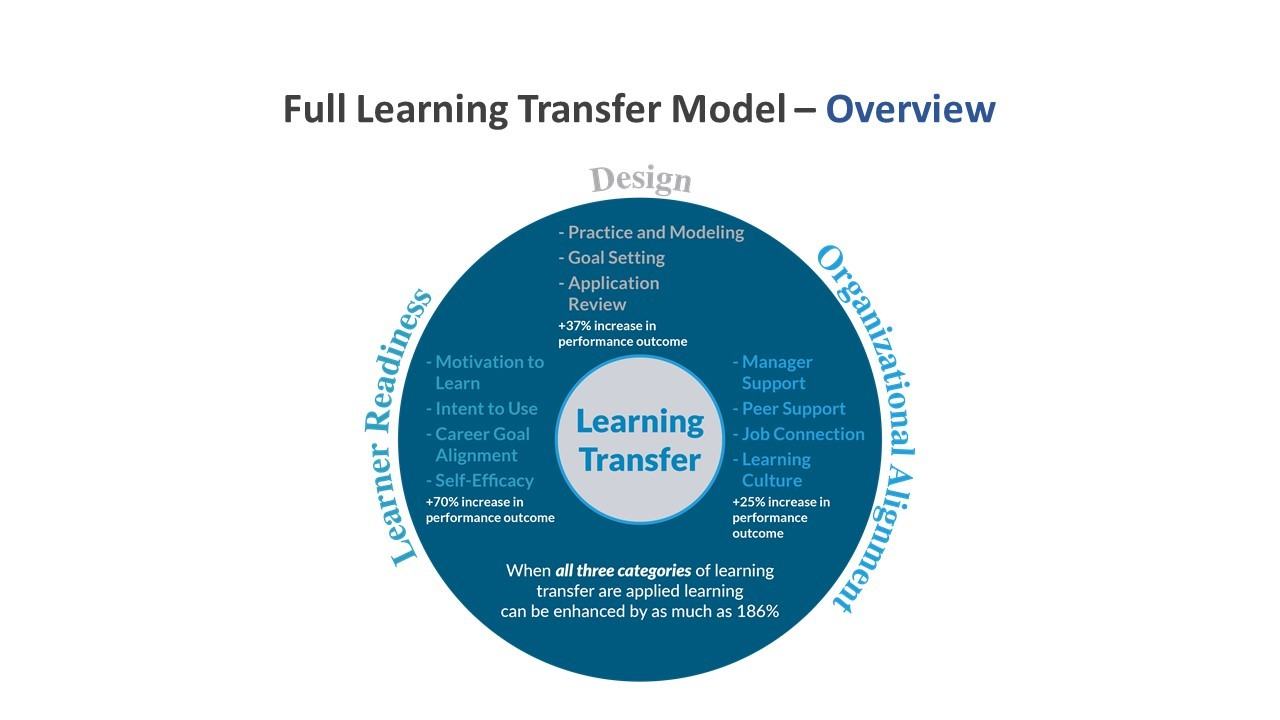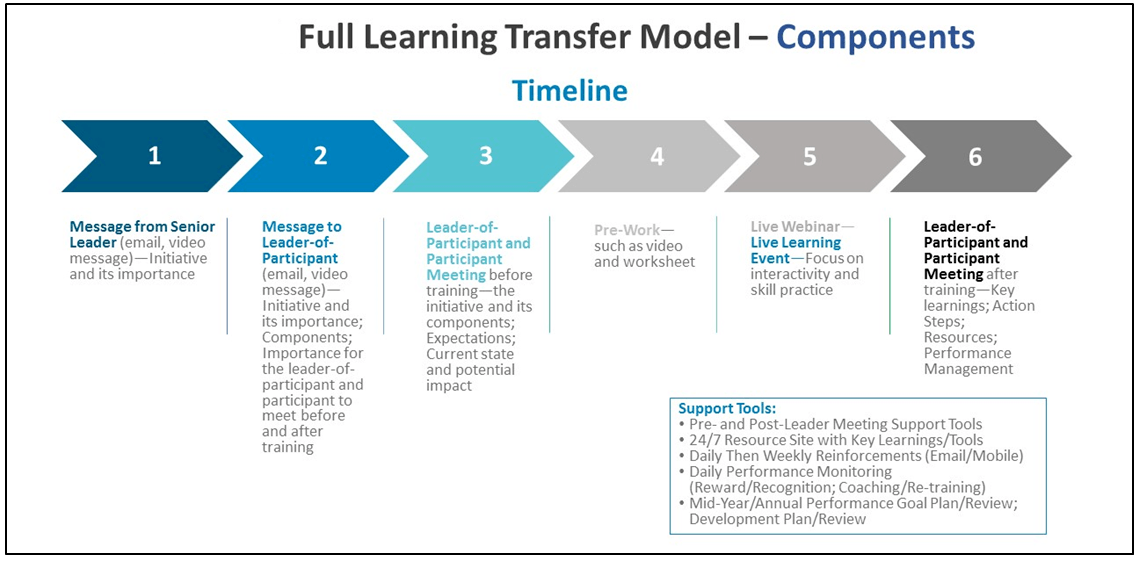Virtual Instructor-Led Training
Virtual Instructor-Led Training (VILT) is critical in our world today. You know how you can work so hard to create or convert to VILT and you and your company still aren’t meeting desired training, performance, and business metrics? That can be solved with the VILT Full Learning Transfer Model (VFLTM). For a comparatively reasonable amount of work, the organization can go from failure to a near 100% success rate. This article will provide you with the steps to do this. Think of the benefits to your organization’s learning, performance, and business metrics.
Critical Need
As much as 20% of all performance is driven by training, including VILT. Yet, as much as 79% of VILT does not improve performance and business metrics. The causes for this are found in factors throughout the system that enables learning. These factors increase more and more in their impact as they get closer to the VILT event. The Full Learning Transfer Model addresses those factors nearest to the VILT event and has the most impact on the VILT event’s effectiveness.
Overview
Three main areas affect VILT effectiveness: Instructional Design, the Organization, and the Learner. When all three are addressed, the VILT impact can be improved by up to 186%. Addressing the Learner can impact the VILT’s effectiveness by 70%. It includes intent, self-efficacy, career goal, and motivation. Addressing the Design can impact VILT effectiveness by 37%. It includes goals, application, and modeling. Organizational Alignment can impact VILT effectiveness by 25%. It includes peer and leader support, culture, and connection to the job.

VFLTM Components
The three main areas are each addressed by developing/delivering a number of VFLTM components. The VILT initiative begins by identifying a Senior Leader to sponsor a message about the VILT and why it’s important. A second communication is sent to the Learner’s Leader reiterating what VILT is and why it is important, the different parts of the VILT program, and the critical importance to meet with the Learner before and after the VILT.
In the meeting before the VILT, the Learner’s Leader discusses the VILT and why it’s important, the different parts of the VILT program, and the Leader’s expectations for the Learner to complete the VILT and come back with action items. They also discuss the current state of where the company, department, team, and Learner currently are with regard to the performance gap being addressed in the VILT, as well as the impact on the customer. Finally, they discuss the positive impact on each of those once the performance is improved. Pre-work can precede the VILT event. Then, the main VILT takes place. There are specific best practices that must be included to make the VILT effective, such as practicing the skills and continual interactivity. The Leader and the Learner meet after the VILT to review the key learning and planned action steps. Also discussed are the new learning resources now available for learning along with the Leader’s performance management of the Learner.
Performance support tools are developed including Pre- and Post-Leader Meeting Quick Reference Guides, a site that includes key learnings, and tools from the VILT available 24/7 for Just-In-Time use. Key learnings from the VILT will be reduced in size and sent to the Learner starting immediately after the VILT—daily for the first week and just once a week after that. The Learner’s Leader will monitor their performance and either reward and/or recognize or coach and re-train as necessary. Also, the VILT will be entered into the performance and development plans/review.

So How Is It Done?
All the VFLTM components can be executed with little expertise and in just a few days. This is a comparatively small effort compared to the huge impact of moving from an 80% failure to a near 100% success rate.
Identify a senior-level leader who can act as a sponsor for the VILT. Design and launch a communication plan that includes communication from that senior-level leader to everyone affected by the initiative. The message details the VILT program and its importance. A second communication is sent from the senior-level leader to the learners and their leaders, again about the VILT program and its importance. The communication also details the different parts of the VILT program and the critical importance for the learner and their leader to meet both before and after the VILT.
Design/develop two Quick Reference Guides (QRGs) for the leaders of the learners. These detail how the leader should conduct the meetings with the learners before and after the VILT.
Create a resource site that the learner can access immediately after the VILT. It has key learnings and tools from the VILT for Just-In-Time use. Also, break down the key learnings into smaller bites of information and correspond via email (or deliver via mobile, etc.) daily for the first week after the VILT, and then weekly thereafter.
Sample Quick Reference Guides For Pre-/Post-VILT Event Meetings
Let’s dive deeper into the two QRGs.
Pre-VILT Event Meeting QRG
For the QRG for the meeting before the VILT, organize it into purpose, process, and payoff. For the purpose, you can share, "The purpose of this Quick Reference Guide is to provide you, the leader of the participant, topics to review, explore, and share with the participant during the meeting that is to be held before the VILT event."
For the process, review the initiative and why it’s critical, explore your direct report’s team regarding its current state and goals for engagement and turnover, and share expectations.
Regarding reviewing the initiative and why it’s critical, have the leader share how the direct report must perform the new behavior such as "coach other" in order to gain the benefits, such as improve business metrics. The direct report must perform differently in order to do that. The direct report needs to effectively learn how to apply new knowledge, skills, and attitudes in order to perform differently, and that successful learning and application take multiple learning activities including this meeting, pre-work (video and worksheet), live learning event, post-event meeting with you, 24/7 access to engagement and turnover tools, weekly emails with reminders about what they learned, and evaluation at mid-year and annual performance reviews.
Regarding exploring your direct report’s team regarding its current state and goals for engagement and turnover, have the leader ask, “What do you think is the current state of what the VILT is addressing on your team?” and “What are your goals for that on your team?” For each question, acknowledge/discuss responses as appropriate, including sharing your view of their team regarding the VILT subject matter.
Regarding sharing expectations, have the leader share that the direct report is to complete all learning tasks within the initiative; to come away from the live learning event with action items to improve what the VILT is addressing; and that the leader will be monitoring these action items for completion and will evaluate them at their mid-year and annual performance reviews.
Regarding exploring the benefits of successfully completing this VILT initiative and applying the new knowledge/skills, have the leader ask, “When you complete this initiative and apply what you’ve learned, what do you think will be the payoff for you? Your team? The department? The company?” Also, have the leader respond to each question, acknowledge/discuss responses as appropriate, including sharing the view of their team regarding the payoff for each area.
For the third and final major section of the QRG, the payoff, include benefits such as improved customer satisfaction, etc.
Post-VILT Event Meeting QRG
For the QRG for the meeting after the VILT, like the previous QRG, organize it into purpose, process, and payoff. For the purpose, you can share, "The purpose of this Quick Reference Guide is to provide you, the leader of the participant, topics to explore and share with the participant during the meeting that is to be held after the live learning event."
For the process, explore key learnings from the live learning event, explore what new actions will be taken to gain the expected benefits/results of the VILT, and share next steps.
Regarding exploring key learnings, have the leader ask, “What were your key learnings/takeaways from the live learning event?” Acknowledge/discuss responses as appropriate, including sharing your view of their key learnings/takeaways.
Regarding what new actions will be taken to obtain the expected benefits/results of this VILT, have the leader ask, “What new actions will you take to achieve expected end benefits/results on your team?” And, for each question, acknowledge/discuss responses as appropriate, including sharing your opinion of their action items and any additional action items the leader thinks are necessary.
Regarding sharing next steps, have the leader say, “I expect you to complete these action items and achieve the expected benefits/results. I will monitor the completion of these action items and their results—reward/recognize or coach as necessary—and review this during your formal mid-year and annual performance reviews. And, for ongoing support, you’ll have 24/7 access to key learning modules and tools on the VILT site at 'such and such' location, and will begin receiving weekly emails reinforcing what you’ve learned.”
For the third and final major section of the QRB, the payoff, include benefits such as reduced costs, etc.
Full Change Management Model (FCMM)
So now you’re aware you must include the Full Learning Transfer Model to go from a high VILT failure rate to an almost 100% success rate. However, change management best practices must also be used because VILT is a change initiative. The absence of these best practices leads to a 70% failure rate of change initiatives.
The best practices for change mostly align with the FLTM. They include designing and implementing the plan in five areas: finding a key sponsor, communications/announcements, the VILT event, leader coaching, and managing those who continue to resist the change. Notice how the first four are explicitly implemented through the FLTM and the fifth factor is implied.

Sources:
- Full Learning Transfer Model
- IPILT Conversion to VILT Processes and Best Practices
- Virtual Learning Transformation Best Practices









